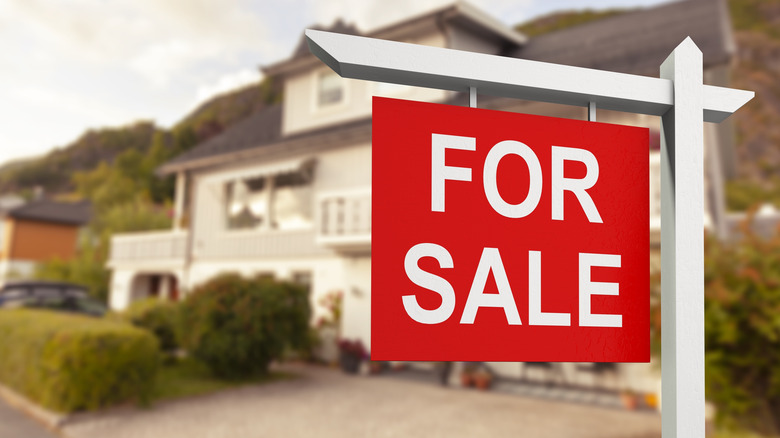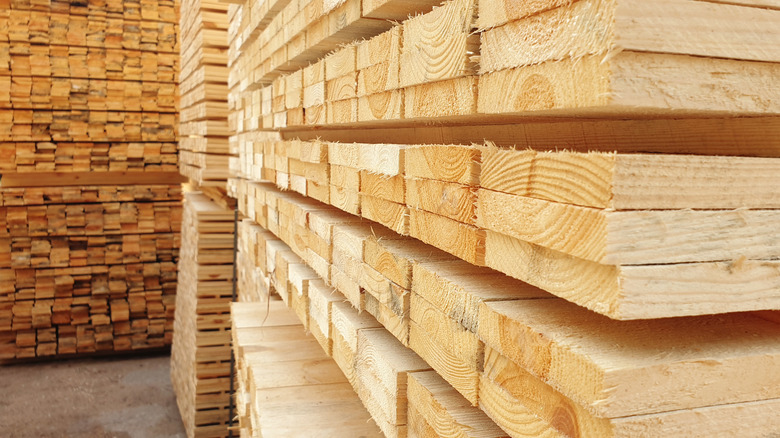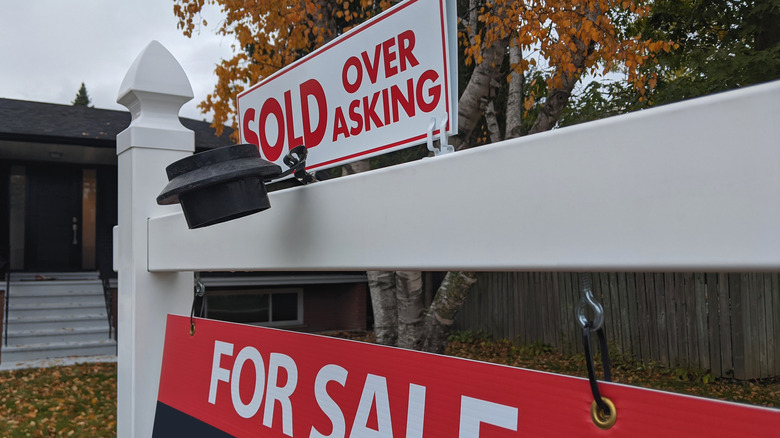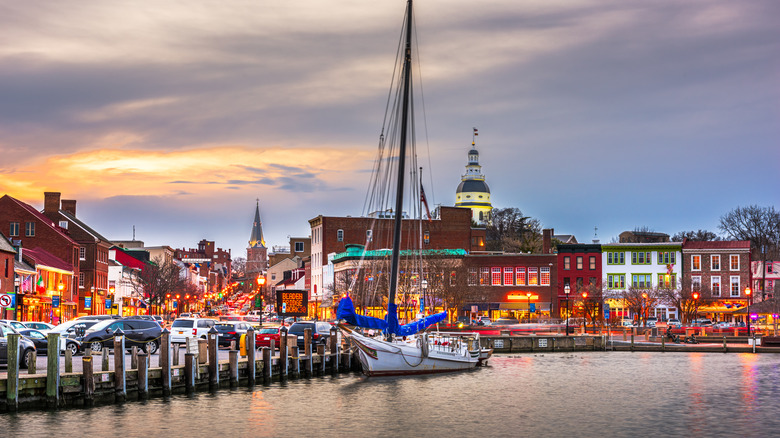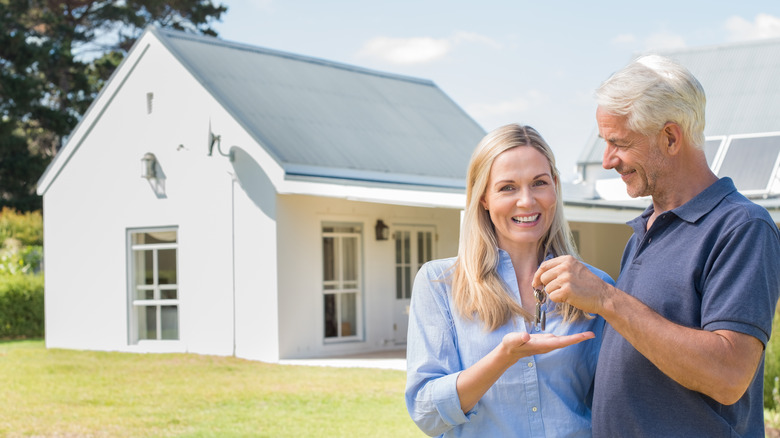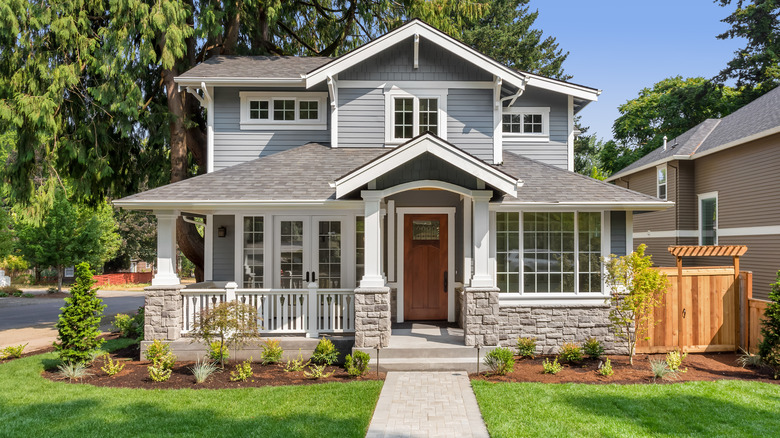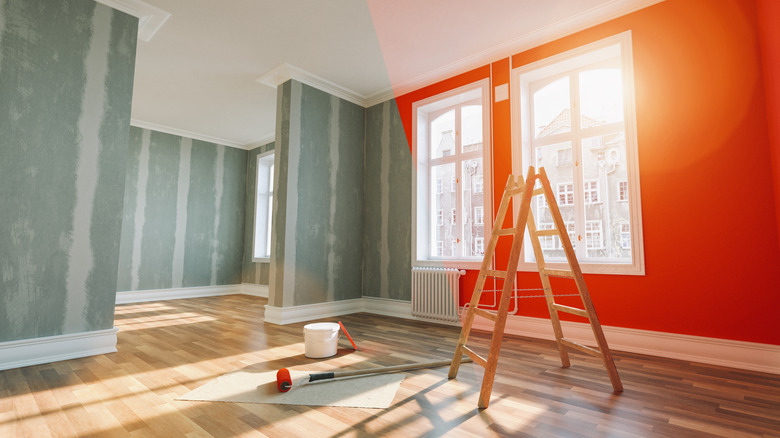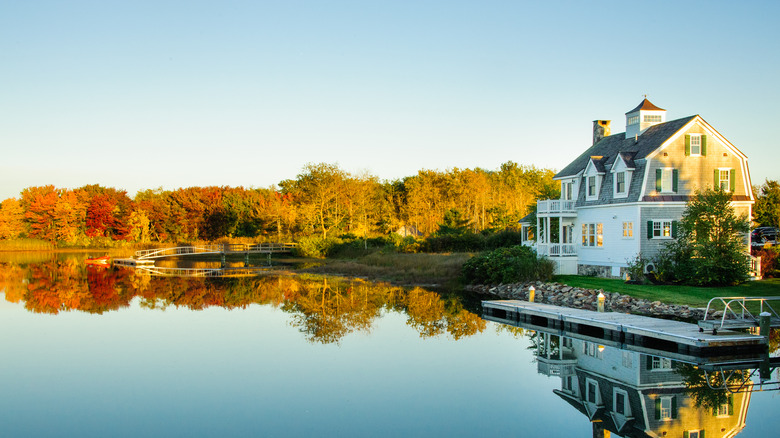Ways COVID Has Really Helped And Hurt The Real Estate Industry
The years 2020 and 2021 have been a challenging ride for our country and the entire world because of the coronavirus pandemic. As a result, many industries and businesses have faced drastic changes. Few, though, have been impacted more than the residential real estate industry. Property values traditionally fluctuate according to economic factors and can greatly impact the economy. Over 65% of homes in the United States are owner-occupied, according to the Congressional Research Service, so the impact of real estate fluctuations on the health of the U.S. economy cannot be overstated.
Unlike other recessions in the past, RSM reported, the chaos in 2020 was not caused by economic crises, financial instability as in the "dot-com bubble" of the 2000s, or irresponsible lending practices like subprime mortgages, which created the financial collapse known as the Great Recession in 2008. Rather, the 2020 recession was caused by a global health emergency. Prior to the pandemic, the real estate industry was in a good place. Sales were high, inventory was low, home values were growing, and lending was in a good place, RSM noted.
Still, residential real estate went through many pandemic-related changes. Some had a negative impact on the industry, but COVID also created many positive outcomes as well.
Lumber prices shot up because of the scarcity of wood
The construction industry started taking a hit during the pandemic when lumber prices skyrocketed as the supply availability in the U.S. decreased. There were numerous factors that impacted lumber stock, including delays in production due to health regulations, many plant shutdowns, and even a pine beetle infestation in Canadian forests, Forbes noted. Additionally, there were wildfires on the West Coast, along with high tariffs on Canadian wood imports which added to the increased cost as well, according to KGW8. All of these unfortunate events have left builders struggling to keep up with the demand for the construction of new houses, making the scarce lumber even more valuable (via Bloomberg).
The limited lumber supply dropped so low, in fact, that theft of the material became a problem, according to Business Insider, resulting in many businesses having to increase security measures. A man in Seattle, for example, was arrested while attempting to steal 32 pieces of wood worth around $2,300 from a locked lumber yard (via The Seattle Times).
According to Forbes, the average new home sold for $34,000 more in 2020 due, in part, to the increased lumber costs. Renovations also became more costly, with everything from framing materials to deck boards increasing, noted KGW8. However, there seems to be relief on the horizon. Business Insider reported that lumber prices as of June 23, 2021 are down 50% from May 2021. As the vaccinations continue to roll out and the economy rebounds, the lumber value should normalize.
The surge in house buying has resulted in low inventory and high prices
There was an extraordinary boom in homebuyers in 2020 and 2021. In April 2021, 50% of homes listed on the market went under contract in less than a week, The Atlantic reported. The surge in sales has been caused in part by record low mortgage rates, Vox noted, making overall loan terms more appealing and affordable. A decrease of 1% can be significant — a house purchased for $500,000 with 20% down in 2015 at 3.85% would cost $675,083.85 over 30 years, where at the average 2.75% rate on June 21, 2020, would cost $734,834 for the same mortgage term, a difference of $59,751 (excluding taxes and insurance).
Some of the lack of inventory resulted from the Great Recession, Construction Connect shared, when many construction companies closed, and the number of new builds decreased. However, others who might otherwise have sold might have chosen not to list their home due to the uncertainty of moving in the pandemic or a lack of desire to have strangers viewing the home and potentially bringing the virus into their house.
The lack of inventory has resulted in bidding wars and an escalation in prices, with people often offering thousands over asking and making offers on houses sight-unseen. Inventory in some cases has gotten so low, Business Insider reported, that one vandalized, smelly "house from hell" in Colorado Springs received over 70 offers and went under contract for over the list price five days after it was listed.
The pandemic made people reassess where they want to live
The fact that more people have been working remotely has opened up opportunities for workers to live in cities other than large geographical centers. "Home buyers still want to be within commuting distance of large employment centers, but with the prevalence of remote work, they are willing to extend the distance from urban downtowns," George Ratiu, Senior Economist at Realtor.com, told Forbes. "The hottest housing markets in the new landscape are cities which offer desirable amenities — larger homes, leafy neighborhoods, access to the outdoors, walkability and proximity to grocery stores — in a more affordable package," he continued.
The pandemic restrictions, Forbes shared, made people reconsider where they were living. With a major increase in online shopping — even for groceries — the need to be near stores decreased, and social distancing rules made people reconsider crowded cities where capacity restrictions kept many places closed and population density made maintaining distance challenging (via Greystone).
However, people moving from more expensive cities to less costly ones can drive up the prices just from a cash flow perspective. "When people leave multimillion-dollar houses in, say, Los Angeles to plunk down $1 million on a house that was worth $500,000 a year ago, they turn a merely frenzied housing market into a once-in-history, hair-on-fire, what-the-hell-is-happening bonanza," The Atlantic wrote.
People leaving could have a negative impact on large cities
As people leave large, densely populated cities like New York for smaller cities and towns, there is concern that revitalization projects that have been increasing in the last few decades may be threatened, Forbes reported. In addition, Goldman Sachs estimated that over 20% of renters have left large, expensive cities (via Financial News), and they expect some of that relocation to become permanent. Wealthier renters and homeowners are also more likely to be able to afford to move, Greystone noted, leaving the lower income populations in the urban centers.
Businesses are also looking to relocate or open branches in different areas that are less expensive than the traditional big markets like San Francisco, New York, and Chicago, Forbes wrote. Larger small cities have seen growth, especially in areas with pro-business incentives and lower taxes. That allows people who don't want to work from home to consider moving with their company to a city with a better quality of life and lower cost of living. Many businesses are also downsizing the scale of their retail space because of more employees working from home, leaving more corporate real estate vacancies as well. And many small businesses have also closed because of COVID.
With all those factors, the decrease in economic revenue can potentially hurt large cities that need to sustain large transportation and service infrastructures, though the long-term impact of those changes remains to be seen.
Generations of people are behaving differently in regards to real estate
Millennials have been burdened with school debt for many years, and expensive urban locations have often shut them out of home ownership. However, now the ability to work remotely is allowing more of them, especially younger millennials, to move to areas with lower home prices and get in on the property ladder (via CoreLogic). Those who had been able to purchase previously may also looking at the low interest rates as a good opportunity to move to a larger home.
However, there is a lack of inventory, mainly because a good majority of the baby boomer generation is choosing not to sell their homes, according to the Chicago Tribune. Many younger buyers can't afford larger homes, but the older generations aren't leaving their more affordable small bungalows and cottages. Some elderly owners are choosing to "age in place," while others are waiting to ride out the increase in housing prices.
However, as Housing Wire noted, in order to make homes more accessible for their aging owners, some renovations, like adding grab bars to bathrooms, can actually decrease the value when it does come time to sell. And homeowners who have lived in a house for years might not recognize issues with older services like electrical panels that can put off younger home buyers who would see the need for immediate renovations.
People are realizing they need more room
As houses became home offices and home schools, as well as living areas, many families have also recognized the need for more space, or that the function of their home no longer fits their family's new lifestyle when they're all at home together. Many big city apartment dwellers confined to small studios during lockdown found the spaces claustrophobic and restrictive when the rest of the city was no longer an extended living space for them. For some renters, that might mean changing locations, but for others, it simply means a need to increase square footage.
Kevin Sneddon of Compass' The Private Client Network coined the change in spaces as "the great real estate shuffle" and noted many people are changing their housing situations because their needs are not being met. "As everyone wants more out of a home — and more out of living — everyone seems to be in some sort of a living transition," he said (via Elite Traveler).
As a result, many families searched for new homes with more square footage than their existing home, reported Forbes. And many looked to new build homes, so they could not only get better space usage, but also upgrades like flex space, home offices, and high speed internet.
Rather than moving, many people are renovating their houses instead
With more people spending time working and living at home, previously overlooked repairs and issues with layout became glaringly obvious, resulting in a wave of home improvements. A Bank of America poll in mid-2020 noted that 70% of Americans planned to do some renovations that year, MarketWatch reported. While open-floor plan concepts were popular for many years, Architectural Digest related that people are now looking to carve out designated areas within the home and return to a more traditional layout with more clearly defined rooms. And according to Forbes, multi-use spaces, as well as home gyms, study areas, and home offices — particularly with the ability to close doors to keep out the rest of the home noise — have all been popular renovations.
Some updates were also implemented because buyers — particularly younger, first-time homeowners — have been buying fixer uppers that needed renovation, which tended to be in more affordable price brackets. All the home updating was good financial news for home improvement stores like Lowes and Home Depot, as well as garden centers and paint specialists like Sherman Williams, who benefit from the additional consumer spending.
It's not the first time that a pandemic has changed home design. Forbes pointed out that ground floor powder rooms became popular during 1918 flu pandemic so visitors wouldn't have to use the family bathroom upstairs, and Victorian-era carpets were replaced with easy-to-sanitize tile after a cholera epidemic in London.
People are prioritizing outdoor space
After being cooped up in their homes for most of the winter, there is now also a greater demand for outdoor spaces in homes, such as patios, balconies, and backyards, giving families the ability to escape the confines of their home and to welcome guests safely (via Architectural Digest). Designing a new outdoor space, searching for a new home, and expanding and improving existing outdoor spaces have all become more of a priority. Forbes also noted that sales of outdoor exercise and entertainment equipment like trampolines and swimming pools have surged in popularity.
People have also started to garden more. With store shelves at times running bare and people worrying about food shortages, NPR reported, vegetable gardens have surged in popularly, with seed companies seeing a explosion in sales. George Ball, executive chairman of the Burpee Seed Company, told NPR, "We're being flooded with vegetable orders." Many companies, including Burpee, had to at times temporarily suspend orders so they could catch up. There has also been increased demand for vertical growing products to help grow food in small spaces.
In addition, people are now increasingly considering moving to warmer climates where outdoor dining and activities are available year-round. Many Southern cities that were often considered by some to be too hot or too unsophisticated have seen a surge in interest and people relocating there, Forbes reported.
Wealthier buyers are buying second homes
Buyers with additional disposable income have been increasingly buying second homes as well, away from the hustle and bustle in areas that felt removed from the pandemic. President and COO of Douglas Elliman Scott Durkin noted to Elite Traveler, "People wanted to keep their homes in the city, but invest in a larger 'safe haven' home in the country or by the beach to use when needed."
They're also spending more time in their vacation homes. Elite Traveler explained that, while previously people might have had a vacation residence where they spent weekends or occasional holidays, during the pandemic, many people spent long periods of time, weeks or months, at their second home, especially in areas with more relaxed COVID restrictions than major urban areas.
But although they're looking to go out to the country and get away from the pandemic, there are limits to how far they really want to go. Rather than choosing to find "off the grid" places, they still want connections to some amenities like high speed internet. "While everybody's talking about this quest for rural locations, there is a sense that they'll only go so far," said Kate Everett-Allen, head of international residential research at global real estate consultancy agency Knight Frank. "They still want to be able to get their Amazon delivery."
The government response was helpful in maintaining a stable housing industry
One of the greatest impacts in maintaining a solid base in the real estate market were some of the federal governmental policies and protections that were put in place in the beginning of the shutdown period, RSM reported. Foreclosure moratoriums and mortgage payment forbearance programs enabled suddenly unemployed homeowners to stay in their homes while looking for new positions. And prohibitions on eviction also helped financially-challenged renters from becoming homeless. State and local eviction and foreclosure orders were also beneficial.
The addition of federal unemployment wages, plus the federal stimulus disbursements, also assisted in rent and mortgage payments. And the 2021 Emergency Rental Assistance Program (ERAP) is providing $1.6 in funding to states for affected tenants to apply for rental relief, Newsday reported. Eligible applicants could receive up to 12 months in back rent and utility bills. Because of those policies, there wasn't an increase in foreclosures that drastically affected the real estate market in 2008 and caused a crushing drop in home values. With that stability, investors felt safe continuing to invest in real estate, giving the market the boost to continue on the upward valuation trend.
However, many landlords, especially those in large cities, have been struggling themselves. With decreased rental income from their properties, some have decided to just sell their properties. New Jersey attorney Jim Clark told Newsday, "With landlords unable to enforce their leases for over a year-and-a-half, many landlords are throwing in the towel and just want to sell."
Still, many groups are being shut out of the housing market
The increased property values aren't good for everyone, however. As real estate values increase in towns that were previously affordable, local residents can get priced out of the property market, with out-of-town investors and wealthy buyers with deep pockets putting in ridiculously overpriced offers.
Young people, low-income wage earners, and people of color are disproportionally affected, Insider reported. Vox noted that a Urban Institute report on homeownership showed "the racial homeownership gap between Black and white Americans is set to increase among 55- to 64-year-olds from 28.9 percentage points to 33.3 percentage points." In addition, systemic racial bias in the home appraisal process, both against Black homeowners and Black appraisers, needs to be addressed to stop the tendency towards lower valuations in primarily Black neighborhoods.
In order to prevent that, the Urban Institute recommends increasing financial education opportunities, updating home ownership qualification processes, and creating programs to assist in home ownership for lower income families and people of color. There also needs to be a push to build an adequate number of new houses to provide opportunities for more people to get on the property ladder. Hopefully, with the continued normalization of lumber costs, a calming of the real estate market, and an easing of pandemic restrictions and fears, those goals can be achieved to allow more Americans to become homeowners.
